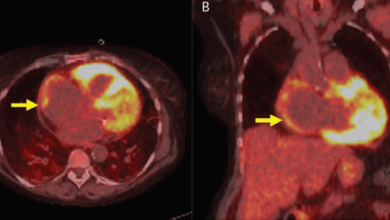Search results
Electrical Mapping to Optimise Heart Failure Outcomes Following Cardiac Resynchronisation Therapy
Author(s):
David O’Donnell
Added:
8 years ago
Article
Author(s):
Rodrigo Gallardo Lobo
,
Michael Griffith
,
Joseph De Bono
Added:
3 years ago
Around 0.8% of live births are affected by some type of congenital heart disease; 30–50% of whom will need one or more surgical interventions, generally during early childhood, involving in some cases complex corrections with patches, baffles or extracardiac circuits.1,2
As a result of advances in surgical interventions, the life expectancy of patients with congenital heart disease has…
View more
Author(s):
Nisha Gilotra
,
David Okada
,
Apurva Sharma
,
et al
Added:
3 years ago
Sarcoidosis is an inflammatory granulomatous disease that can affect any organ. Systemic sarcoidosis is known to affect young adults, with a second peak in women >50 years of age, as demonstrated in Scandinavian and Japanese studies.1–4 In the US, the lifetime risk of sarcoidosis is 2.4% for black people and 0.85% for white people.1 The incidence of cardiac involvement has been increasingly…
View more
Author(s):
Eyal Nof
,
William G Stevenson
,
Roy John
Added:
3 years ago
Sustained ventricular tachycardia (VT) and ventricular fibrillation (VF) are typically a manifestation of significant structural heart disease and often associated with a high risk of sudden cardiac death. Implantable cardioverter defibrillators (ICDs) remain the mainstay of therapy for prevention of sudden cardiac death associated with these arrhythmias.1 However, ICDs treat the arrhythmia after…
View more
Author(s):
Konstantinos D Rizas
,
Wolfgang Hamm
,
Stefan Kääb
,
et al
Added:
3 years ago
Experimental and clinical studies have demonstrated that enhanced sympathetic autonomic nervous system (SANS) activity can destabilise myocardial repolarisation,1–4 increasing vulnerability to developing fatal cardiac arrhythmias.5–8 Accordingly, assessment of SANS activity has always been a major goal for cardiac risk stratification methods. Various non-invasive methods including assessment of…
View more
Added:
6 years ago
Author(s):
Melani Sotiriadou
,
Antonios P Antoniadis
,
Nikolaos Fragakis
,
et al
Added:
2 years ago
Added:
6 years ago
Author(s):
Jonathan S Steinberg
,
David Slotwiner
Added:
3 years ago
Electrical Remodelling
Evidence Supporting Atrial Remodelling
The concept of electrical remodelling was first introduced in 1995 simultaneously by Wijffels et al.1 and Morillo et al.2 who demonstrated that once sustained atrial fibrillation (AF) was induced in goats, or rapid atrial pacing was performed in dogs, physiological changes occurred that favoured the maintenance of AF.3 This led to the…
View more
Author(s):
David D Spragg
,
Irfan Khurram
,
Saman Nazarian
Added:
3 years ago
Atrial fibrillation (AF) is a remarkably common arrhythmia, affecting roughly 6 % of patients over 65 years of age, with an estimated US prevalence of over two million patients.1 That prevalence is likely to increase as patients live longer, and will contribute to rising morbidity and mortality over time.2-4
Efforts to treat AF remain imperfect. Rhythm control approaches typically consist either…
View more















 « First
« First